Z68 SSD Caching with Corsair's F40 SandForce SSD
by Anand Lal Shimpi on May 13, 2011 3:06 AM ESTAnandTech Storage Bench 2011 - Heavy Workload
Last year we introduced our AnandTech Storage Bench, a suite of benchmarks that took traces of real OS/application usage and played them back in a repeatable manner. I assembled the traces myself out of frustration with the majority of what we have today in terms of SSD benchmarks.
Although the AnandTech Storage Bench tests did a good job of characterizing SSD performance, they weren't stressful enough. All of the tests performed less than 10GB of reads/writes and typically involved only 4GB of writes specifically. That's not even enough exceed the spare area on most SSDs. Most canned SSD benchmarks don't even come close to writing a single gigabyte of data, but that doesn't mean that simply writing 4GB is acceptable.
Originally I kept the benchmarks short enough that they wouldn't be a burden to run (~30 minutes) but long enough that they were representative of what a power user might do with their system.
Not too long ago I tweeted that I had created what I referred to as the Mother of All SSD Benchmarks (MOASB). Rather than only writing 4GB of data to the drive, this benchmark writes 106.32GB. It's the load you'd put on a drive after nearly two weeks of constant usage. And it takes a *long* time to run.
First, some details:
1) The MOASB, officially called AnandTech Storage Bench 2011 - Heavy Workload, mainly focuses on the times when your I/O activity is the highest. There is a lot of downloading and application installing that happens during the course of this test. My thinking was that it's during application installs, file copies, downloading and multitasking with all of this that you can really notice performance differences between drives.
2) I tried to cover as many bases as possible with the software I incorporated into this test. There's a lot of photo editing in Photoshop, HTML editing in Dreamweaver, web browsing, game playing/level loading (Starcraft II & WoW are both a part of the test) as well as general use stuff (application installing, virus scanning). I included a large amount of email downloading, document creation and editing as well. To top it all off I even use Visual Studio 2008 to build Chromium during the test.
The test has 2,168,893 read operations and 1,783,447 write operations. The IO breakdown is as follows:
| AnandTech Storage Bench 2011 - Heavy Workload IO Breakdown | ||||
| IO Size | % of Total | |||
| 4KB | 28% | |||
| 16KB | 10% | |||
| 32KB | 10% | |||
| 64KB | 4% | |||
Only 42% of all operations are sequential, the rest range from pseudo to fully random (with most falling in the pseudo-random category). Average queue depth is 4.625 IOs, with 59% of operations taking place in an IO queue of 1.
Many of you have asked for a better way to really characterize performance. Simply looking at IOPS doesn't really say much. As a result I'm going to be presenting Storage Bench 2011 data in a slightly different way. We'll have performance represented as Average MB/s, with higher numbers being better. At the same time I'll be reporting how long the SSD was busy while running this test. These disk busy graphs will show you exactly how much time was shaved off by using a faster drive vs. a slower one during the course of this test. Finally, I will also break out performance into reads, writes and combined. The reason I do this is to help balance out the fact that this test is unusually write intensive, which can often hide the benefits of a drive with good read performance.
There's also a new light workload for 2011. This is a far more reasonable, typical every day use case benchmark. Lots of web browsing, photo editing (but with a greater focus on photo consumption), video playback as well as some application installs and gaming. This test isn't nearly as write intensive as the MOASB but it's still multiple times more write intensive than what we were running last year.
As always I don't believe that these two benchmarks alone are enough to characterize the performance of a drive, but hopefully along with the rest of our tests they will help provide a better idea.
The testbed for Storage Bench 2011 has changed as well. We're now using a Sandy Bridge platform with full 6Gbps support for these tests. All of the older tests are still run on our X58 platform.
AnandTech Storage Bench 2011 - Heavy Workload
We'll start out by looking at average data rate throughout our new heavy workload test:
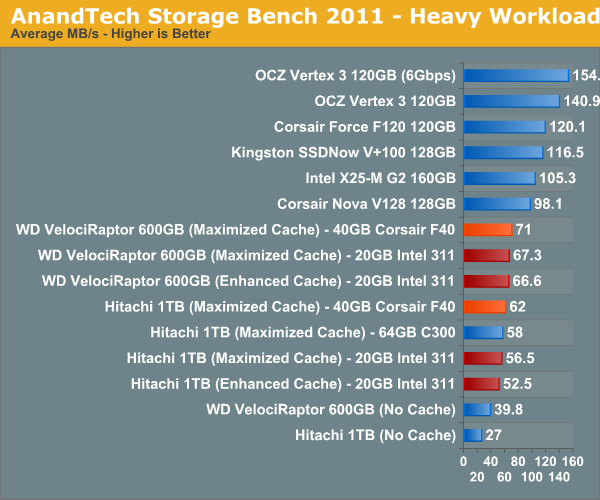
In our launch article we found that even Crucial's 64GB RealSSD C300 wasn't able to significantly outperform the 311, the situation isn't much different with the F40. The good news is that you do get twice the capacity and technically better performance, which could result in more of your data being in the cache at once.
The breakdown of reads vs. writes tells us more of what's going on:
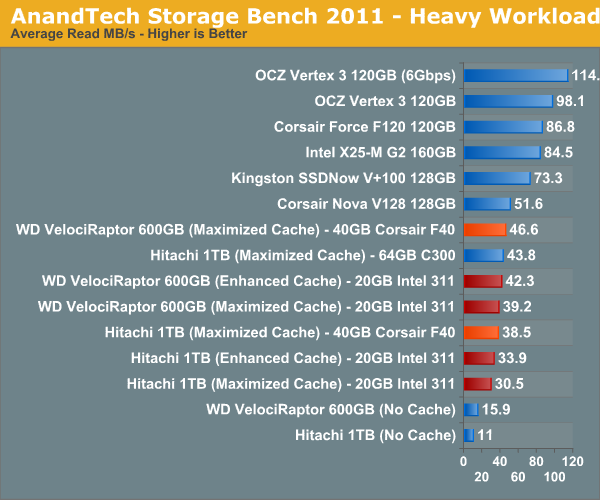
Read performance is actually where the F40 shines, surprisingly enough. This would imply that the majority of reads being cached are highly compressible in nature, playing to the F40's strengths. The write performance is a different story however:
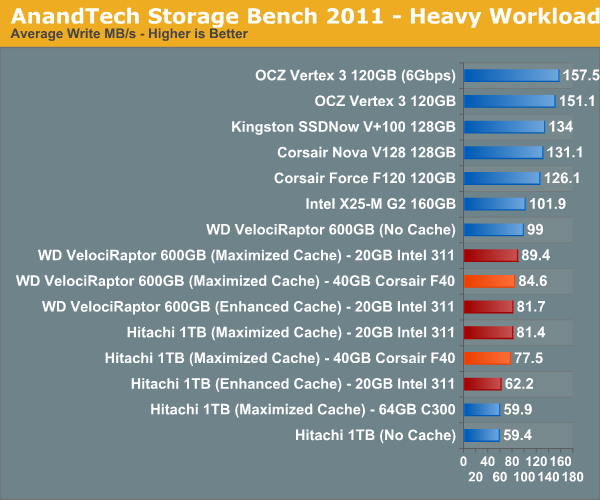
There isn't a huge difference here, but the 311 does pull ahead in the writes that occur during our test. Overall I'd say the F40 and 311 are pretty equal here, which is a good thing given the capacity advantage.
The next three charts just represent the same data, but in a different manner. Instead of looking at average data rate, we're looking at how long the disk was busy for during this entire test. Note that disk busy time excludes any and all idles, this is just how long the SSD was busy doing something:
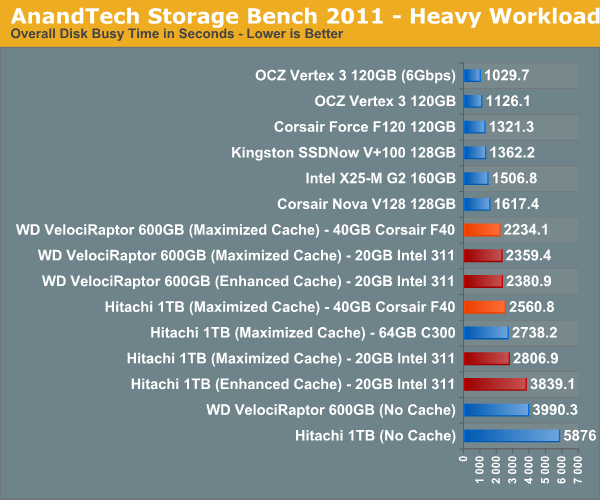

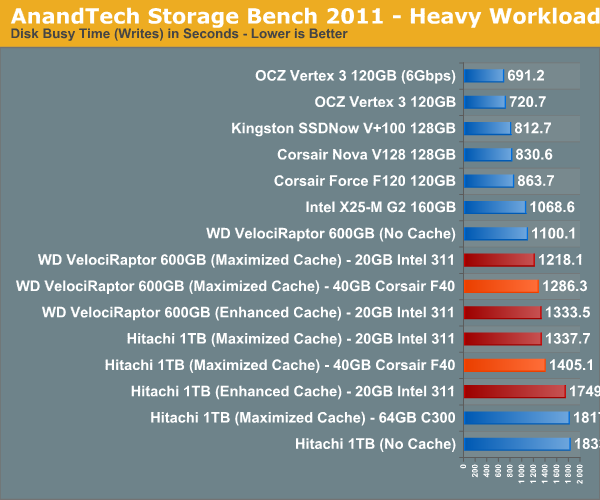










81 Comments
View All Comments
chromatix - Friday, May 13, 2011 - link
The improvement only shows that *some* of the applications remained in cache for the second run (on the smaller 311). There are any number of reasons why some but not all of them would remain resident - the caching algorithm is almost certainly not pure LRU.With the larger F40, more stuff remains in cache and so the performance improvement is greater. This is wonderful news for people (like me) who have an enormous Steam installation and are seriously running out of SSD space to put it on.
beginner99 - Friday, May 13, 2011 - link
... but not now. There are some gains compared to HDD only but if you factor in at what cost it's debatable compared to a standalone ssd. The speed boost doesn't seem that great and worse unpredictable.Can you comment on real-life experience?
Current HDDs are pretty fast or fast enough in like 90% of the times. But what sucks is the stuttering that happens. Is this 100% prevented with caching? Probably only with maximize options which is risky. hence you actually lose the most important benefit of the ssd: No Stuttering
DanNeely - Friday, May 13, 2011 - link
Not sure I agree totally. While the ultimate SSD experience is a 120+GB drive that can store your OS and a large chunk of your apps, that's too expensive for anyone but fairly deep pocketed enthusiasts to afford. $100 SSDs are easier to justify from a cost perspective, but their limited capacity would traditionally require large amounts of micromanagement in order to get any effective use out of them. Rapid response gives a decent benefit without the micromanagement. To really take off though, it needs $50 or $30 SSDs not $100 ones.Patrick Wolf - Friday, May 13, 2011 - link
I think that's the main bullet point Anand is missing. Yes, an SSD + a storage HDD that you manage manually is technically the fastest solution. However, the whole point of an SSD is increased productivity. In computing, seconds matter and If you have to spend any time managing what's stored on your SSD and HDD it's time you could be spending doing normal tasks.GullLars - Tuesday, May 24, 2011 - link
Actually, with W7 it takes just a few hours after a clean install the first time you do it to make stuff go on the SSD or HDD, and tweak it so it's fairly optimal. If you have done it before, or have a good guide, it can easily be done in under 1 hour, and a scheduled run of Ccleaner once a day or week keeps the temp crap from building up.I had a 64GB SSD RAID (2x32) from 2008 to 2010, and have had a 32GB SSD in my laptop since 2009. Space was never an issue. Last fall (2010) i went for 4x C300 64GB on SB850 to get well over 1GB/s reads and max my southbridge on IOPS. I still haven't used more than 80GB including all apps and games.
slyck - Saturday, May 14, 2011 - link
Don't forgot the added cost of the Z68 motherboard. Intel will make a killing both ways on this one, more expensive mobo, and a quite high cost $/GB SSD.GullLars - Tuesday, May 24, 2011 - link
The high $/GB of 311 isn't margins for intel. SLC is twice as expensive as MLC in die costs alone, and then you have to factor in production scale, making it a bit more expencive. A rule of thumb is SLC cost being about 2,5X MLC. The 311 is not 2,5X the price of x25-V 40GB. Intel's margins would be higher if you got x25-V instead, which would make sense if you could use it as a read-only cache, but they didn't even allow that option...cavalier695 - Friday, May 13, 2011 - link
I wonder how the performance would be in a laptop. Maybe using a drive like the 40GB Intel 310 Series SSD. The mSATA form factor would be very useful in laptops where a having second 2.5" bay for holding a second drive is rarely possible. Would this work and if so is it possible AT might do some benchmarks or a review for it?modnar58 - Friday, May 13, 2011 - link
With regards to "I believe there's a real future with SSD caching, however the technology needs to go mainstream. It needs to be available on all chipsets"What about standalone controller cards that offer SSD caching like HighPoints $60 card? http://www.highpoint-tech.com/USA_new/series_rh122...
evilspoons - Friday, May 13, 2011 - link
I saw a review of that card on Tom's Hardware (I think)... the results were very mediocre compared to Intel's implementation.